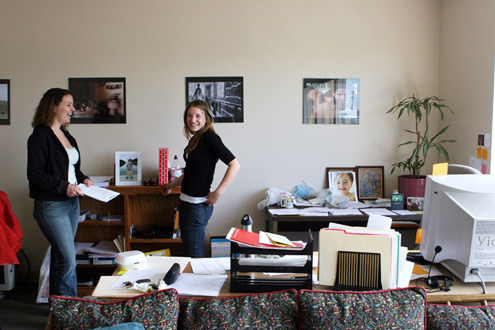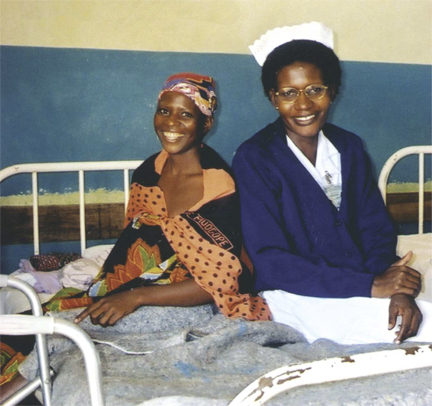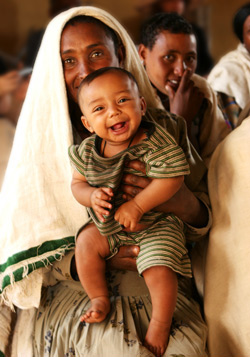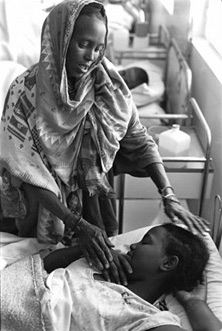The latest member of the New Founders Program is a non-profit organization, One By One. Founded by Katya Matanovic and Heidi Breeze-Harris, One By One’s mission is to end obstetric fistula, a childbearing injury that is affecting more than two million women around the world, particular those in poor communities. In most cases of untreated fistula, the children will die and the women are left with frequent ulcerations and infections – and they are often abandoned by family and ostracized by their community. It is an injury that is preventable and treatable (the UN Population Fund estimates the cost to be $300 per case), but it has been relatively neglected.
One By One strives to end fistula by increasing public awareness and raising public financial support for direct grants to support fistula prevention and treatment. They also have a modest goal to inpire people that, with small steps and grassroot works, we can make a difference in global public health issues.
Here at Harvest, we are thrilled to be able to contribute to such an organization, and we are honored to present to our community One By One’s inspiring story. One By One’s executive director, Heidi Breeze-Harris, has graciously given us the time in answering these questions, and we hope that you enjoy reading the interview as much as we have.

How did you learn about obstetric fistula, and what made you want to start One By One?
I learned of obstetric fistula when I was three months pregnant, very ill from pregnancy, and I was home in bed watching a lot of television, including The Oprah Winfrey Show. I watched an Oprah program on obstetric fistula in Ethiopia and afterwards I decided to do some research to learn more about the issue. I had lived in India and couldn’t believe that I had never heard of the injury when I felt quite sure that it must be happening there. I was riveted by the fact that the injury was so devastating, physically, socially and economically, and yet so treatable and even preventable. I have a background in women’s issues in the developing world and I was deeply saddened by the particular plight of women and girls suffering from fistula. My sadness was met by an equal feeling of anger that, once again, women and girls were ‘getting the short end of the stick in the world’ and I decided I had to do something to help. I couldn’t, for even one more moment, abide hopelessness about the world that had been mounting in me so I got up and went to the internet to learn more and figure out how to give whatever I could. I felt like I had something to contribute to helping fistula become a memory.
What are some of the challenges you’ve faced during the first year of starting the organization?
Our very first year of operations we were a volunteer group that was fiscally sponsored by the UN Foundation and in partnership with the UN Population Fund’s Campaign to End Fistula. Being individual volunteers in partnership with the UN is a very interesting process as you may imagine. It proved to be a challenging but wonderful way to get started and to really feel like we were supporting both treatment and prevention with our efforts which was of paramount importance to us and still is.
Since May of 2006 we have been our own independent non-profit organization. We went from using all my personal computer equipment and my office in my basement to having a small office, needing computers, software and all the important aspects of running a business without the help of a fiscal sponsor. Building the infrastructure from the ground up is a taxing process because there are a lot of administrative details as well as important steps a non-profit must take to insure the actions they are taking in the world are worthwhile and that the money they raise is being used correctly. We take that very seriously. And yet we still have the original program work to do which is engaging the public in learning about obstetric fistula and what they can do to help and then giving grants to worthy programs in the developing world that treat and prevent fistula.
There is always more work to do than there are hours in the day. And yet we are very committed to our work and we seem to continue to be met in the world by amazing people that share their tremendous energy to help One By One do all that we can do in the world. As Teddy Roosevelt said: ‘Do what you can, where you are, with what you have.’ It may be complex, and sometimes tiring to the bone marrow, but it is also exciting and that makes it possible to get up every day and do what needs to be done. We have so much amazing help from the community and such partnership with the programs in the developing world that we are thankful to be able to spend our time with the noble people that work with us day in and day out.

What’s the one thing you love most about running One By One?
The people.
Whether that be our Board of directors, my colleagues at One By One or UNFPA or the UN Foundation, the volunteers who help me in the office, interns who do work for us, donors who call to tell us why they care, school teachers who tell us about engaging their students in the issue, our partners in organizations like the Sierra Club, or elementary school kids who empty their piggy banks when they hear that $2 makes a difference, or magazine editors and writers who take a chance to write about a little organization like ours, or the doctors and nurses who perform fistula surgeries in Tanzania, or the women and girls themselves… who are strong…their strength brings tears to my eyes every day. My favorite job is working with the people. We seem to attract really terrific people and every single person I meet teaches me something new, makes me reflect on important philosophical ideas or simply inspires me with their energy, their tenacity, their creativity and their strength. I am in love with hopefulness and individuals. Individual people, each with their unique ideas and styles, they give me joy in the present and hope for the future.
What have you learned from running One By One?
Fistula is an amazing issue to work on and I am honored and humbled to do the grassroots work to help end this injury. It galvanizes people in very interesting ways because no one in the world would want a woman or girl to suffer from fistula for any reason or for any amount of time. And the fact that it is an injury, not a disease, and that with development it has largely been eliminated from the developed world, is inspiring. It brings a large set of global public health issues into focus as imminently solvable. That is a powerful message especially when so many messages we all receive about the world, and certainly about public health, often feel hopeless or simply too huge or too far from our expertise to get involved with. I applaud the many individuals, organizations and governments that work on all levels on these huge issues and especially the programs that put the needs of women and girls at the top of the pyramid.
I also must put my pitch in for mothers: they deserve more than just a day per year to be honored. They are the workhorses of the world and they have my undying admiration for successfully getting through each day whether they are here in Seattle, in Tanzania or anywhere else.
How did you get the word out and gain the support you have for One By One?
We get the word out through our programs of public engagement first and foremost. Secondly people learn about us via the web and our website, by word of mouth, through events and through the media, both traditional and alternative. Individuals are a wonderful way to spread the word  viral marketing as it were. When people feel inspired, they are the greatest advocates for an issue and we depend on inspired individuals, largely, to spread the word about the issue, about us and the particular way we work at the grassroots level.

From a media standpoint, we have been fortunate to have a wide range of people, publications and outlets interested in our work. We have been in several magazines nationally including the UN Chronicle and Cookie with articles that highlight our work or talk about our work alongside the work of other like organizations. We have been on the radio and we have been given numerous awards that allow us an opportunity to talk more about how and why we work. Each time is different and inspiring and we are grateful for the opportunities. Media has been critical to our success. We are also in partnership with other groups that work on media such as the Campaign to End Fistula and we appreciate the work they do both on the issue and the amazing work they do to publicize it internationally.
We are fortunate, now, to have a pro-bono marketing firm called Marketing Alchemist that creates our strategies and we have a wonderful PR/Marketing Intern named Olivia Garrow who executes on the strategies that Marketing Alchemist creates. It is amazing to have this help because it extends the ability of our small staff and yet doesn’t create strain for our budget.
How come a non-profit organization like yours needs to track time, and how has Harvest helped you in that regard?
It is important that we properly allocate our time between activities that are programmatic, administrative and fundraising. This is critical for reporting to our donors and to the IRS. Proper tracking also helps us learn where we are spending our time in reality vs. how long we think a project or task will take and that is useful for planning for the future.
We do so many different things in a day that we were having a hard time keeping really crisp records of our time. Harvest is so easy to use, is web based so I can use it anywhere, and the clock function makes me want to cry it is so useful. Now we not only have crisp time sheets that speak to us about categories and days vs. weeks vs. months, but making and submitting them hardly takes anytime at all, and that is keyâ€â€keep the administrative work efficient so we can focus on program.
What are some essential daily tools for you?
The most important tool is a picture of my 2 1/2 year old son, Coleman, and my husband Jack. They are the most important parts of my life and I draw inspiration and strength from them. Of course the next most important tools are all about computers…hardware, software, printer, internet connectivity, things like Skype that let me talk to other parts of the world easily and inexpensively and my phones…couldn’t live without my phones though some days I’d like to live without them!

I take breaks at work by reading Ode Magazine, World Pulse and Kyoto Journal, three alternative, very hopeful, beautiful publications.
I enjoy beauty and our office is filled with gorgeous large photographic prints of women from Africa taken by our Program Director, Ms. Shaleece Haas, who is an accomplished documentary photographer. I love them and they inspire me greatly, keep me connected to the work at hand when I am knee deep in budgets or tax forms that are important but less inspiring on a moment-by-moment basis. And lastly but not least I keep bag after bag of almonds in my desk drawer. I live on almonds and water.
Is there any tool you wish you have but does not exist or is inaccessible?
For the developing world there is a litany of tools that either do not exist or are not accessible to folks. I wish all our partners could have satellite phones and digital cameras and ways to download and ship images of what they face everyday, and a way to send some of their written or oral versions of their experiences to us. Those sorts of connections and technologies would help us do our job more effectively and efficiently. But really, if those tools were already available to them, then frankly, they should also have the more immediate needs for women met first…safe birthing kits like the ones PATH creates for rural births, basic transportation to go to a birth center when women need help, to have the hospitals they arrive at be equipped with sutchers, transfusion bags and decent surgical equipment with lights and electricity and well, I could go on and on…you get the point.
On a much more mundane note regarding tools I’d like, everyone keeps different kinds of calendars, has different preferences about IM services, and likes different web-based ways to share and edit documents. I have so many different groups to keep track of on different services with different passwords that it really hampers my ability to be efficient. I wish there were one service that had it all and that everyone would just agree to use. I think my wish is a mix of a tool plus agreement between people on working styles that is probably unrealistic but it is still my wish.
I also wish my computer monitor would dispense caffeine when I ask it to.
How do you see One By One a year from now?
We are in a steady process of growing, but growing at our own pace. Next year we will make even bigger grants and hopefully we will add even one more grantee program. We hope to be making a short film about our work next year as well so that will be an exciting addition to our work. Our ability to increase our public engagement programming to include more college students, high school students and things like pro-bono architects and doctors and nurses could be an exciting development as well.
Our most important goal is to continue doing a high quality job of engaging the public in the developed world in the issue of treating and preventing obstetric fistula alongside the work to take that energy and money and give it, properly, to worthy programs in the developing world. We will continue to choose grantees that are equally grassroots so that what we give will be transformational for their work. It is important to us to have that level of partnership with our grantees and be able to know how our energy is making a difference for them, in a very detailed way.
If you could end fistula tomorrow, what would you do next?
First, I would have a party with all the hundreds of people who have spent their lives or even part of their lives to see obstetric fistula end knowing that the end of fistula also means, inherently, that women and girls have, by then, been given much more power in the world.
After such public merriment, I would, in this order: turn my phones off, set an auto-reply on my email and buy 3 plane tickets. I would take my son and my husband to Italy for the summer to rest and bask in beauty. While there we would ride bicycles, meet people and I would paint and drink copious quantities of organic red wine, eat much pasta and move as slowly as possible, taking great joy in the small, the beautiful, the delicious and the ordinary. Life is a beautiful place and I have been moving a bit too rapidly around it for a tad too long.
How do you relax yourself outside of work ?
The absolute best thing in the world to me is to laugh or make someone else laugh. That sounds incredibly stupid but it is true. So I act silly and encourage all silliness.
Next on the list is that I am an obsessive reader of the New Yorker magazine and always either reclining in bed or reclining on the couch which we fondly call ‘the nap vortex.’ I read all the cartoons first – front to back. (I always think I will submit a caption to the caption contest and I stew on caption options with my husband for days and then always forget to submit.) Then I go back to the back of the magazine and allow myself to thumb through and read whichever article strikes me first, then second then third. The only exception to that rhythm is if I see anything by Malcom Gladwell, James Surowiecki or David Sedaris.
I listen to fiddle music and wish I could play my violin like Michael Doucet of Beausoleil.
I make art.
I ski in the winter and play frisbee in the summer and hang out at any and every beach as often as possible.
I meet friends for dinner.
I go book shopping.
And lastly are lazy weekends with family. On Saturdays we sleep in, eat Swedish-style toast and drink coffee from our favorite coffee shop called Nervous Nellies which feels like an extension of our living room. Then we go and swing on the chair sculptures at the new Olympic Sculpture Park and then we go watch the jelly fish cruise the jelly fish circle at the Seattle Aquarium and culminate with a visit to the local skate park and watch kids do tricks. We then barbecue salmon or eat chips and salsa on the back deck. And once Coleman is asleep, Jack and I watch a movie. That is a day from heaven.
What is some advice you’d give to someone who’s starting their non-profit organization?
Ask your family for forgiveness every day for they will miss you often. And be prepared to miss them.
You will lose sleep so research age-defying cream now and apply it every night or you will look like death warmed over.
Follow your vision with great gusto and be open to but not necessarily swayed by everyone you meet or everything you hear.
Nothing is impossible though there are plenty of days where that doesn’t feel true. So get some good friends and family who agree that you will need special attention and reminders to prop you back up when you fall over.
Don’t knock the importance of a good bookkeeper and accountant.
I love to thank people and I think it is very important so I’d advise people to remember to thank and give credit where credit is due.
Infrastructure building for someone like me is painful but thank god for the people who make me do it. It is critical to the foundation of good work that will last.
Don’t make rash decisions….the whole deal can be a roller coaster and how you feel today may not be at all how you feel tomorrow.
Ask for help. You can’t do it alone and why would you? It is less fun that way.
Diversify your income base as quickly as possible.
Never assume that growth for growth’s sake is necessarily good strategy. There is great beauty in small and medium-sized initiatives.
Watch out for jadedness in yourself or others… it is toxic.
If you are indeed the one starting the organization, don’t take it too seriously….it is an experiment and when you hold on too tightly the magic disappears.
Thanks to Heidi of One by One for sharing with us their inspiring story. If you wish to learn more about One by One and obstetric fistula, please visit their website – http://fightfistula.org













